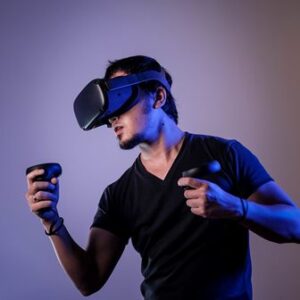Thanks to advancements in extended reality (XR), the world may look very different in the not-so-distant future. As the boundaries of human-machine interface evolve, and as 5G enables the untethered use of immersive technologies that can merge the physical and virtual worlds (technologies like augmented reality and virtual reality), we’re likely to see notable changes in our personal and professional behaviors. The rapid growth in extended reality will disrupt many parts of society, from how we learn, work and recreate, to how we socialize and shop. Respected futurist and tech advisor, Bernard Marr, says that in light of the rapid development of extended reality technologies, companies are already starting to re-imagine their business processes and customer service experiences. And with the growth in extended reality set to accelerate, there are exciting opportunities for businesses and investors that get in front of the trend.

Bernard Marr – a bestselling author, popular keynote speaker, futurist, and a strategic business and technology advisor to governments and businesses. Bernard helps organizations understand the implications of new technologies such as artificial intelligence, big data, blockchains, and the Internet of Things. His most recent book is Tech Trends in Practice (April 9, 2020).
What Is Extended Reality (XR)
Extended reality is a blanket term used to describe immersive technologies that can merge the physical and virtual worlds. XR technologies either blend the virtual and real worlds, or they create a fully immersive experience unto themselves. Varied forms include: augmented reality (AR), virtual reality (VR), and mixed reality (MR), though the list is not inclusive (there may be new forms of XR that are yet to be created).
Thanks to rapid technological advancements, extended reality is beginning to make its way into industry, as well as our personal lives. XR is supplementing human reality and disrupting everyday tasks. And it won’t be long until people routinely interact within a hybrid of real and virtual worlds.
To get a better understanding of extended reality, the following is a brief overview of the three distinct forms – AR, VR, and MR.
Augmented Reality (AR)
 In augmented reality, digital information is superimposed on top of the real world. Its essentially a new reality layered on top of your existing one. This enhances the real world with digital images, text, animation, and sound. Augmented reality can be experienced through AR glasses or on computer devices with a camera (like tablets and smartphones).
In augmented reality, digital information is superimposed on top of the real world. Its essentially a new reality layered on top of your existing one. This enhances the real world with digital images, text, animation, and sound. Augmented reality can be experienced through AR glasses or on computer devices with a camera (like tablets and smartphones).
AR is arguably the simplest of the three extended reality subsets, requiring the least amount of processing power. Its only logical that its also the most widely adopted. The most well-known example of AR is Pokémon GO, a game that overlays digital creatures onto a screen showing the player’s real-world surroundings. But AR is slowly making its way into areas beyond entertainment. Sectors such as education, retail, online shopping, and manufacturing are also finding practical use cases for augmented reality.
Virtual Reality (VR)
 In contrast to augmented reality, in a virtual reality experience users are fully immersed in a simulated digital environment. Participants put on a VR headset (a head-mounted display), in order to achieve a 360 degree view of a digital world. These headsets generate realistic sounds and images, tricking the person’s brain into believing that they are actually present in their new, computer-simulated environment. In addition, users can also supplement the sound and audio of the VR headset, with controllers, haptic devices and other sensory stimulators, with the goal of engaging all five senses, for a truly immersive experience. And sure, while there are a lot of improvements to be made before virtual reality can rival the real world, technological innovation is hastening the day when we’ll have trouble distinguishing fantasy from reality. This includes advancements in processing speed, refresh rates, audio integration, video quality and complexity, movement tracking, and a host of new sensory devices.
In contrast to augmented reality, in a virtual reality experience users are fully immersed in a simulated digital environment. Participants put on a VR headset (a head-mounted display), in order to achieve a 360 degree view of a digital world. These headsets generate realistic sounds and images, tricking the person’s brain into believing that they are actually present in their new, computer-simulated environment. In addition, users can also supplement the sound and audio of the VR headset, with controllers, haptic devices and other sensory stimulators, with the goal of engaging all five senses, for a truly immersive experience. And sure, while there are a lot of improvements to be made before virtual reality can rival the real world, technological innovation is hastening the day when we’ll have trouble distinguishing fantasy from reality. This includes advancements in processing speed, refresh rates, audio integration, video quality and complexity, movement tracking, and a host of new sensory devices.
At present, the gaming and entertainment industries are the leaders when it comes to VR technology adoption. But other industries are catching up. Areas such as healthcare, construction, engineering, and the military are also finding practical use cases for virtual reality.
Mixed Reality (MR)
The latest immersive technology – a hybrid of augmented reality and virtual reality – is known as mixed reality. MR blends real and virtual worlds to create complex environments where digital and physical elements can interact with one another in real time. Like AR, it overlays synthetic content in a real-world environment. And like VR, the content is interactive, so users can manipulate the digital objects in their physical space.
Mixed reality’s limitations lie in the processing capabilities of available devices. MR headsets require a lot more processing power than similar devices running AR or VR. But as highly complex MR devices become more powerful, efficient, compact, and affordable, this technology will find its way into our everyday lives. In fact, mixed reality has already made its way into employee and military training, retail, and manufacturing sectors. And more and more companies are starting to explore new ways they can put mixed reality to work to solve problems, support initiatives, and make their businesses better.
A great example of mixed reality (MR) is Microsoft Mesh. In essence, it allows you to place digital objects into a physical room, then spin, manipulate and interact with these virtual objects within the parameters of your physical environment. To get a better idea of Microsoft Mesh mixed reality, check out the short explainer video below…
Real-World Applications For Extended Reality
There are many practical applications of extended reality. Here are just a few…
Entertainment
Entertainment is the most obvious use case for XR. An early adopter of immersive technologies, the entertainment industry is working on new ways to disrupt 2D media and enhance live events. With VR headsets, consumers have the opportunity to experience live concerts and sporting events as if they were there, while VR movies and video games can provide a truly “out of this world” experience. Even live events will eventually see the incorporation of augmented and mixed reality for an enhanced experience.
Education & Training
Another use case for extended reality that is seeing early adoption, is in education and training. XR activates multiple sensory channels concurrently, and evidence shows that engaging more than one sense when teaching can help information processing. Therefore it is only expected that we will see more extended reality tools used in our classrooms.
Extended reality is of particular value in training professionals for high-risk jobs. XR can provide training tools that are hyper-realistic, so people who work in life-and-death situations – like pilots, astronauts, soldiers, firefighters – can train in safety, without putting their lives or anyone else’s at risk. In the same respect, healthcare professionals can get hands-on practice with virtual patients so they become proficient before moving on to actual patients. In either scenario, such hands-on training is far more effective than a conventional classroom setting.
Real Estate
XR has the potential to disrupt the real estate industry as well. For realtors, finding buyers and tenants will be much easier if individuals can walk through a space virtually. Yes, while this is already “kind of” possible using online listings (with photos and video), in order to truly appreciate a home or office space – the layout, the views, the communal space – a walk through is vital. With VR, realtors can streamline the rental process by allowing potential tenants or buyers to tour the properties anytime and from anywhere. This will save time and money for both parties. In addition, architects and interior designers can use extended reality to bring their designs to life, catch mistakes, and make changes before they become too costly.
Marketing & Retail
Extended reality is creating new ways for brands to engage with consumers. By offering immersive ways to interact with their products, companies can develop innovative marketing strategies and gives customers the ability to try it on, or try it out, before they buy. Especially in light of the pandemic, people don’t necessarily want to visit a retail shop to try on apparel or try out physical merchandise. Augmented reality and virtual reality are making the customer experience much more hassle free. Already, furniture company IKEA has an AR app that gives customers the ability to place furniture into the home via a smartphone. And pretty soon, we’ll be able to do everything in a virtual store that we can do in a physical store. We’ll be able to test products and use a virtual avatar that matches our physical measurements, to try on clothes and accessories, put on makeup, etc.
Remote Work
Extended reality removes distance barriers, allowing remote workers and specialists to seamlessly access data, interact, and manipulate remote devices from anywhere in the world. Soon we’ll be able to be in the same virtual location with colleagues, patients and clients, regardless of either party’s whereabouts. Just look at how Zoom meetings – in 2D – have transformed the way we work and do business. XR will significantly enhance the quality and effectiveness of these workplace interactions.
And we can completely re-imagine how doctors and technicians will do their work. Just imagine a mechanic putting on mixed reality glasses in order to diagnose internal issues and adjust settings within a client’s car – one that’s still parked in their driveway. Or a doctor wearing mixed reality glasses and performing a complex operation on a patient in another country. These and a multitude of other remote work applications are all possible in the the foreseeable future.
How do you profit from the emerging trend in extended reality (XR)?
To begin with, you need to educated yourself and broaden your knowledge in the area. Only then will you be able to truly appreciate the wide range of opportunities that will emerge as XR technologies evolves.
Learn More About Extended Reality (AR, VR, and MR)
Below are a number of online courses in augmented and virtual reality.
-
Udemy – augmented reality, virtual reality
-
Skillshare – augmented reality, virtual reality
-
Coursera – augmented and virtual reality
-
LinkedIn Learning – augmented and virtual reality
Once you’ve broadened your understanding of extended reality, you’ll be more adapt at identifying quality investment opportunities.
Top Augmented Reality Stocks To Watch
Below are 8 companies that are leaders in the development and adoption of extended reality technology…
Alphabet – Google’s YouTube could become a huge a hub for VR content. Plus their streaming-based Stadia platform could make them a big player in the VR video game market.
Immersion Corporation – known in the VR gaming world, its haptic technology allows people to use their sense of touch to engage with various digital products.
Microsoft – developing an enterprise solution known as the HoloLens, a MR headset used for training or guiding someone through difficult tasks. Their video game brand, Xbox, also has upside potential in the VR gaming market.
PTC – their AR platform facilitates things like workforce training and remote technical services provided from afar using mobile headsets as “virtual eyes” in the field.




